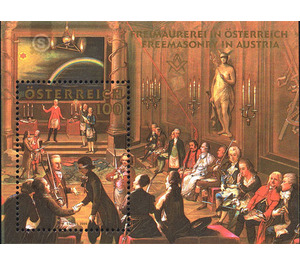Freemasonry - Austria / II. Republic of Austria 2006
Theme: Organiszations & Institutions
| Country | Austria / II. Republic of Austria |
| Issue Date | 2006 |
| Edition Issued | 350,000 |
| Item Type | Block |
| Chronological Chapter | OOS-OE2 |
| Chronological Issue Number | Block 33 |
| SID | 187700 |
| In 52 Wishlists | |
When Mozart started his famous "Journey to Prague", he was said to have driven over Rosenau Castle. Amadeus, the convinced Freemason, wanted to pay a visit to his friends, who founded a Masonic Lodge on the castle of Count Schallenberg in the 18th century. Schloss Rosenau was first documented in 1593. The renaissance castle was rebuilt and extended 150 years later to the plans of the baroque master builder Munggenast. The fact that a box was set up here shows exposed frescoes in the vestibule as well as festively furnished rooms in the south wing. In the time of the occupation after 1945, the castle suffered severely. It was sold to the state of Lower Austria and subsequently restored. The Grand Lodge set up a Masonic Museum on the first floor of the castle, which opened on April 23, 1975. It includes lounges and a historical-reconstructed temple area and shows the history and work of Freemasonry in Austria on the basis of numerous documents and changing special exhibitions. Freemasonry originated in London in 1717 and spread rapidly. Freemasonry came to Austria via Duke Franz Stephan of Lorraine, the future husband of Maria Theresa. He was consecrated in the Hague in the Hague and later promoted Freemasonry in Austria, where he prevented the proclamation of the papal excommunication bull against the Freemasons (1738). In 1742 the first box "Aux Trois Canons" was founded in Vienna. The 1784 pronounced prohibition of Freemasonry had initially only formal character, because as early as 1780 the lodges were legally recognized in Austria. 1784 was the "Great Landesloge". Since its inception, Freemasonry has supported the ideas of the Enlightenment and Josephinism. At that time, the most important men of cultural and public life belonged to the lodges, such as the famous physician van Swieten or Joseph von Sonnenfels, also Joseph Haydn and Wolfgang Amadeus Mozart. This dedicated the opera "Magic Flute" to the chair-master Ignaz von Born and took him as a model for the figure of Sarastro. Towards the end of the 18th century, the lodges came under state control, were exposed in the time of Metternich the spying system as well as the persecution. Only after the settlement with Hungary (1867) came for the Masons a more favorable time. However, they were only able to join the "border boxes" established on Hungarian soil, such as the one in Neudörfl in what is today Burgenland. In 1918 the "Grand Lodge of Vienna" was founded, in 1945 the "Grand Lodge of Austria" was established and currently comprises around 2,400 members in 52 lodges.


